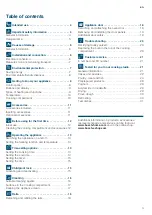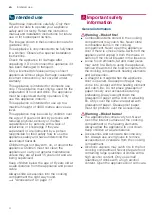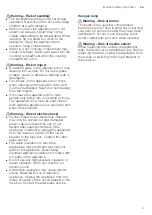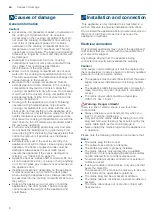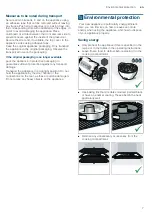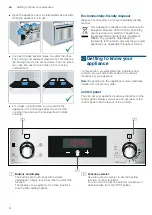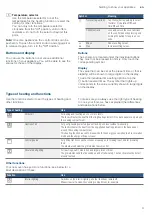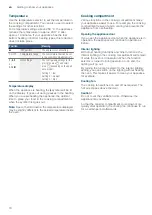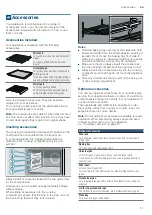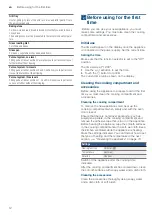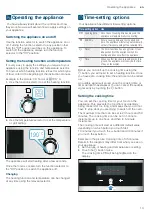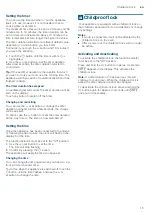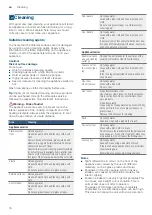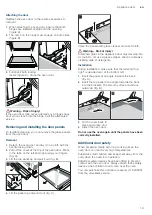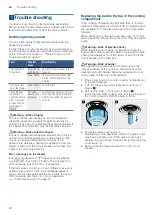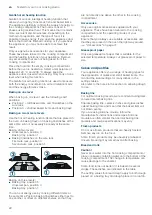
en
Causes of damage
6
]
Causes of damage
Causes of damage
General information
Caution!
■
Accessories, foil, greaseproof paper or ovenware on
the cooking compartment floor: do not place
accessories on the cooking compartment floor. Do
not cover the cooking compartment floor with any
sort of foil or greaseproof paper. Do not place
ovenware on the cooking compartment floor if a
temperature of over 50 ºC has been set. This will
cause heat to accumulate. The baking and roasting
times will no longer be correct and the enamel will
be damaged.
■
Aluminium foil: Aluminium foil in the cooking
compartment must not come into contact with the
door glass. This could cause permanent
discolouration of the door glass.
■
Water in a hot cooking compartment: do not pour
water into the cooking compartment when it is hot.
This will cause steam. The temperature change can
cause damage to the enamel.
■
Moisture in the cooking compartment: Over an
extended period of time, moisture in the cooking
compartment may lead to corrosion. Allow the
cooking compartment to dry after use. Do not keep
moist food in the closed cooking compartment for
extended periods of time. Do not store food in the
cooking compartment.
■
Cooling with the appliance door open: Following
operation at high temperatures, only allow the
cooking compartment to cool down with the door
closed. Do not trap anything in the appliance door.
Even if the door is only left open a crack, the front of
nearby furniture may become damaged over time.
Only leave the cooking compartment to dry with the
door open if a lot of moisture was produced whilst
the oven was operating.
■
Fruit juice: when baking particularly juicy fruit pies,
do not pack the baking tray too generously. Fruit
juice dripping from the baking tray leaves stains that
cannot be removed. If possible, use the deeper
universal pan.
■
Extremely dirty seal: If the seal is very dirty, the
appliance door will no longer close properly during
operation. The fronts of adjacent units could be
damaged. Always keep the seal clean. Never
operate the appliance if the seal is damaged or
missing.
~
"Cleaning" on page 16
■
Appliance door as a seat, shelf or worktop: Do not
sit on the appliance door, or place or hang anything
on it. Do not place any cookware or accessories on
the appliance door.
■
Inserting accessories: depending on the appliance
model, accessories can scratch the door panel
when closing the appliance door. Always insert the
accessories into the cooking compartment as far as
they will go.
■
Carrying the appliance: do not carry or hold the
appliance by the door handle. The door handle
cannot support the weight of the appliance and
could break.
5
Installation and connection
Installation and connection
This appliance is only intended to be fully fitted in a
kitchen. Observe the special installation instructions.
Do not install the appliance behind a decorative door or
the door of a kitchen unit, as this may cause the
appliance to overheat.
Electrical connection
Only licensed specialists may connect the appliance.It
is important that you comply with the requirements of
your electricity supplier.
Any damage arising from the appliance being
connected incorrectly will invalidate the warranty.
Caution!
If the supply cord is damaged, it must be replaced by
the manufacturer, its service agent or similarly qualified
persons in order to avoid a hazard.
■
The appliance must be disconnected from the power
supply whenever installation work is being carried
out.
■
The appliance fulfils the requirements of protection
class I and may only be connected to an earthed
socket.
■
The mains power cable must be at least type
H05 V V-F 3G, 1.5 mm².
:
Warning – Danger of death!
There is a risk of electric shock if you touch live
components.
■
Always make sure your hands are dry when you
touch or hold the mains plug.
■
Only pull out the mains cable by taking hold of the
plug and removing the plug; never pull it out by the
mains cable itself, as this could damage it.
■
Never unplug the mains plug when the appliance is
in operation.
Please note the following information and ensure that:
Notes
■
The mains plug fits the socket.
■
The cable cross section is adequate.
■
The earthing system is properly installed.
■
The mains cable is only replaced by a qualified
electrician (if this is necessary).Spare mains cables
can be ordered from our after-sales service.
■
No power strips/multi-way connectors or extension
cables are used.
■
If using a residual current device, only use one that
bears the mark
z
.
The presence of this mark is the only way to be sure
that it fulfils all the applicable regulations.
■
The mains plug can be accessed at all times.
■
The mains cable is not kinked, crushed, modified or
severed.
■
The mains cable does not come into contact with
heat sources.
Environmental protection
en
7
Measures to be noted during transport
Secure all mobile parts in and on the appliance using
an adhesive tape that can be removed without leaving
any traces. Push all accessories (e.g. baking tray) into
the corresponding slots with cardboard at the edges, in
order to avoid damaging the appliance. Place
cardboard or similar between the front and rear side to
prevent knocks against the inside of the glass door.
Secure the door and, if available, the top cover to the
appliance sides using adhesive tape.
Keep the original appliance packaging. Only transport
the appliance in the original packaging. Observe the
transport arrows on the packaging.
If the original packaging is no longer available
pack the appliance in protective packaging to
guarantee sufficient protection against any transport
damage.
Transport the appliance in an upright position. Do not
hold the appliance by the door handle or the
connections on the rear, as these could be damaged.
Do not place any heavy objects on the appliance.
7
Environmental protection
Environmental protection
Your new appliance is particularly energy-efficient.
Here you can find tips on how to save even more
energy when using the appliance, and how to dispose
of your appliance properly.
Saving energy
■
Only preheat the appliance if this is specified in the
recipe or in the tables in the operating instructions.
■
Leave frozen food to defrost before placing it in the
cooking compartment.
■
Use baking tins that are dark-coloured, painted black
or have an enamel coating. These absorb the heat
particularly well.
■
Remove any unnecessary accessories from the
cooking compartment.
Summary of Contents for HHF133B.0B
Page 2: ......



